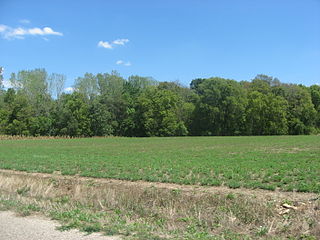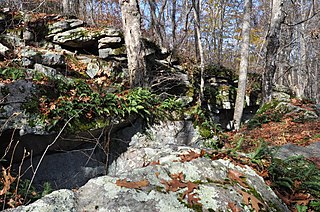
The Stoner Site is a substantial archaeological site in the far eastern portion of the U.S. state of Illinois. Discovered during the Great Depression, the site has produced large numbers of artifacts from a prehistoric village that was once located there, and archaeological investigations have shown it to be one of the area's most important archaeological sites for the Allison-Lamotte culture. After more than a decade of fruitful research and predictions of potentially rich results from future work, it has been designated a historic site.

The Gardiner Pond Shell Midden is a prehistoric archaeological site in Middletown, Rhode Island, named after George Gardiner who was an early settler in the area. The site includes a large shell midden, in which archaeological finds have been made dating the area's human habitation to the Middle and Late Woodland Period. Finds at the site include agricultural tools such as hoes, planting tools, and stone mortars and pestles. The midden is on the grounds of the Norman Bird Sanctuary.
Pine Hill Archeological Site, RI-655 is a prehistoric archaeological site on Prudence Island in Portsmouth, Rhode Island. The site's principal feature is a coastal shell midden dating to the Late Woodland period. Finds at the site include projectile points, stone tools, bones, and ceramics.

The Tomaquag Rock Shelters (RI-HP-1) are a prehistoric rock shelter site off Maxson Hill Road in Hopkinton, Rhode Island. The shelters are located under two east-facing granite outcrops in the valley drained by Tomaquag Brook. Nathan Kaye discovered the shelters in the late 1950s. Materials recovered from test excavations resulted in dating one shelter to 800 BC and the other to AD 800. Materials recovered include projectile points, stone knives, and evidence of stone tool construction. Both sites included evidence pointing to the presence of a fire pit.
The Carbuncle Hill Archaeological District encompasses a collection of archaeological sites in rural western Coventry, Rhode Island. Designated by the state as sites RI-1072 through RI-1079, this discontiguous cluster of sites has the potential to increase knowledge of prehistoric patterns of stone tool procurement, development, and use. The district was added to the National Register of Historic Places in 1985, primarily for its potential to yield further information.
The Lambert Farm Site, designated RI-269, was a prehistoric archaeological site in Warwick, Rhode Island, United States. The site consisted of a large shell midden and a dispersed collection of associated stone artifacts at an inland location, which were dated to the Late Woodland Period. The site was examined by professional archaeologists in 1980, and was added to the National Register of Historic Places in 1983 for its potential to reveal information about prehistoric land use patterns. It was destroyed in 1991 by residential development of the area, although significant quantities of archaeological material were recovered prior to its destruction.
The Meadows Archeological District is a complex of four prehistoric archaeological sites in Warwick, Rhode Island. Discovered in 1980, the sites exhibit properties associated with the procurement and processing of stone tools. Three of the four sites include evidence of short-term habitation, and all four have shell middens. Occupation periods from the Archaic to the Woodland Period have been assigned to them. The district was added to the National Register of Historic Places in 1982, cited for its potential to yield new information about prehistoric Native patterns of living.
Trafalgar Site, RI-639 is a prehistoric archaeological site in Warwick, Rhode Island. The site's primary component is a shell midden. Finds at the site include stone tools, bone, and tools for working bone.
The Cape Site, designated Site 36.27 by the Maine Archaeological Survey, is a prehistoric archaeological site in West Leeds, Maine. Finds at the well-stratified waterfront site include ceramic fragments, stone tools, and remains of habitation dating as far as 6000 BCE. The site was listed on the National Register of Historic Places in 1992.
Hidden Falls is an archaeological site that contains evidence for the earliest occupation in Southern Alaska along with evidence of marine resource usage. It is dated to the Archaic and Pacific period, between 9,500 and 1800 B.C.
The Carlston Annis Shell Mound is a prominent archaeological site in the western part of the U.S. state of Kentucky. Located along the Green River in Butler County, this shell midden has been declared a historic site because of its archaeological value.
The KYANG site, also known as the Kentucky Air National Guard site or 15JF267, is a prehistoric archaeological site located on the grounds of the Louisville Air National Guard Base in Louisville, Kentucky. The site was occupied from the Early Archaic period to the Late Woodland period. The site includes two zones, both of which contain extensive midden deposits. Burials were also conducted at the site, and human remains have been recovered from both zones. The site was discovered in 1972 during construction work at the base; formal excavations at the site began the following year.
Dewil Valley, located in the northernmost part of Palawan, an island province of the Philippines that is located in the Mimaropa region, is an archaeological site composed of thousands of artifacts and features. According to the University of the Philippines Archaeological Studies Program, or UP-ASP, the closest settlement can be found in New Ibajay, which is covered by the town capital of El Nido, which is located around 9 km (5.6 mi) south-east of Dewil Valley. Physically it measures around 7 km (4.3 mi) long, and 4 km (2.5 mi) wide. It is in this place which the Ille Cave, one of the main archaeological sites, can be found. It is actually a network of 3 cave mouths located at its base. It has been discovered that this site in particular has been used and occupied by humans over multiple time periods.
The Gavin Watson Site, designated Site 59.8 by the Maine Archaeological Survey, is a prehistoric archaeological site in Sullivan, Maine. Located on the shore of Flanders Bay, an inlet off Frenchman Bay in Down East Maine, the site is a refuse midden that is free of shells. An important regional multicomponent site with artifacts spanning thousands of years, it was listed on the National Register of Historic Places in 1987.
The Von Mach Site is an archaeological site in Brooksville, Maine. Located on the south bank of the Bagaduce River opposite Castine, the principal feature of the site is a large shell midden, yielding evidence of a long period of human habitation. When excavated by pioneering Maine archaeologist Warren K. Moorehead in the 1920s, he described one of the ceramic finds at this site among the most finely decorated he had found anywhere on the New England coast. The site was listed on the National Register of Historic Places in 1989.
The Atkinson-Koskinen Site, designated 45.13 by the Maine Archaeological Survey, is a prehistoric archaeological site in or near Steuben, Maine. Its main feature is a non-shell refuse midden, a rarity on the coast of eastern Maine. Along with the Goddard Site in Brooklin, it is important in analyzing land use and subsistence patterns during the Late Ceramic period. The site was listed on the National Register of Historic Places in 1984.
The Devils Head Site, designated Site 97.10 by the Maine Archaeological Survey, is a prehistoric and historic archaeological site in Calais, Maine. Located on the banks of the St. Croix River, it is a shell midden site with evidence of multiple periods of human habitation, from the Middle Ceramic Period to the Late Contact Period and beyond. With its location near Saint Croix Island, the site of an early French settlement in 1604, the site's finds may provide insight into early French-Native relations in the area. The site was listed on the National Register of Historic Places in 2006.
Archeological Site No. 29-64 is a prehistoric archaeological site in Islesboro, Maine. The site encompasses a shell midden, in which are embedded the remains of semi-subterranean pit-house structures. It is one of the best-preserved examples of this type in northeastern North America. The site was listed on the National Register of Historic Places in 1982.
The Great Diamond Island Site, designated Site 9-16 by the Maine Archaeological Survey, is a prehistoric archaeological site on Great Diamond Island in Casco Bay, off the coast of southern Maine. Principally a shell midden, the site is an important window into the habitation and usage history of the Casco Bay region by Native Americans. The site was listed on the National Register of Historic Places in 1979.

The Moccasin Bluff site is an archaeological site located along the Red Bud Trail and the St. Joseph River north of Buchanan, Michigan. It was listed on the National Register of Historic Places in 1977, and has been classified as a multi-component prehistoric site with the major component dating to the Late Woodland/Upper Mississippian period.





